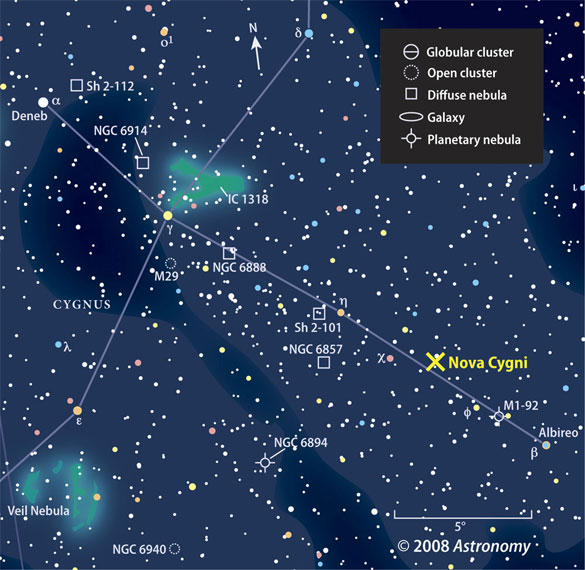Today, I wrote a web-news story about a “new star” in the constellation Cygnus the Swan. In a bit of cross-promotion, I’d like to share the information as a blog.
Late at night on Thursday, April 10, Japanese amateur astronomers Koichi Nishiyama and Fujio Kabashima discovered a possible nova in the Swan. Astronomers initially catalog such events as variable stars. This one received the label V2491 Cygni. Follow-up observations by other astronomers confirmed the object was a nova. Recent estimates place its brightness at magnitude 7.6.
If you’re new to observational astronomy, the magnitude scale provides a way to compare the brightnesses of celestial objects. The brightest stars have magnitudes of 0 and 1, and the faintest stars visible to the unaided eye from a dark site typically have a magnitude around 6.5. The nova, therefore, lies just below the naked-eye visibility limit. This means you can spot V2491 Cygni easily through binoculars.
To spot the nova, use the finder chart at the bottom. Cygnus rises in the northeast and is fully visible just after 11 P.M. local time. It continues to climb higher in the sky until dawn. Tonight, the Moon is a few days after First Quarter. It sits across the sky in the constellation Leo the Lion. Moonset occurs around 3:30 A.M. local time. The nova shines brightly enough that moonlight will not interfere with the view.
If your sky is clear over the next week or so, you may want to sketch or photograph this region each night. Such images will show how the star brightens or fades, and are important in the study of novae. If you’re happy with the images you get, you can submit them to the American Association of Variable Star Observers at www.aavso.org.
A nova is an explosion resulting when hydrogen from one star of a binary system falls onto the surface of the second star, which is a white dwarf. White dwarfs represent the last stage in the lives of Sun-like stars. In such cases, the star shines like the Sun from a few billion to about 20 billion years. Energy production exhausts the nuclear fuel in its core, and the core shrinks. This heats up the core, causing the star’s outer layers to expand. As the core cools, it shrinks to form a white dwarf star.
Nishiyama, 70, is from Kurume, Fukuoka-Ken, and Kabashima, 68, from Miyaki-cho, Saga-ken. Both are well-known supernova hunters. Nishiyama takes images with the duo’s 16-inch (0.4 meter) reflector using a charge-coupled device (CCD) camera in their Miyaki Argenteus Observatory. Kabashima then analyzes the images with a personal computer.

No comments:
Post a Comment